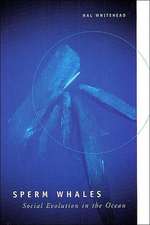The Sonar of Dolphins
Autor Whitlow W.L. Auen Limba Engleză Hardback – 14 ian 1993
| Toate formatele și edițiile | Preț | Express |
|---|---|---|
| Paperback (1) | 947.67 lei 6-8 săpt. | |
| Springer – 26 sep 2011 | 947.67 lei 6-8 săpt. | |
| Hardback (1) | 954.62 lei 6-8 săpt. | |
| Springer – 14 ian 1993 | 954.62 lei 6-8 săpt. |
Preț: 954.62 lei
Preț vechi: 1164.17 lei
-18% Nou
Puncte Express: 1432
Preț estimativ în valută:
182.69€ • 198.37$ • 153.46£
182.69€ • 198.37$ • 153.46£
Carte tipărită la comandă
Livrare economică 22 aprilie-06 mai
Preluare comenzi: 021 569.72.76
Specificații
ISBN-13: 9780387978352
ISBN-10: 0387978356
Pagini: 278
Ilustrații: XII, 278 p.
Dimensiuni: 178 x 254 x 23 mm
Greutate: 0.71 kg
Ediția:1993
Editura: Springer
Colecția Springer
Locul publicării:New York, NY, United States
ISBN-10: 0387978356
Pagini: 278
Ilustrații: XII, 278 p.
Dimensiuni: 178 x 254 x 23 mm
Greutate: 0.71 kg
Ediția:1993
Editura: Springer
Colecția Springer
Locul publicării:New York, NY, United States
Public țintă
ResearchDescriere
Over the ages, humans have always been fasci manner and to present a comprehensive and nated by dolphins. This fascination heightened in organized treatise on the subject. In my opinion, the 1950s when oceanariums and aquariums such an effort is long overdue, since there is a paucity of books on this subject. I know of only began to use dolphins as show performers to one booklet and one book dealing with echoloca demonstrate their prowess and display how tractable and trainable they were. The televi tion in dolphins. I have attempted to introduce as many concepts from physics as possible sion series "Flipper" brought considerable public awareness and, coupled with the growing sophis and also to create mathematical models as an aid to the quantification and understanding of tication and popularity of dolphin shows, helped to further heighten public interest in these intri biosonar capabilities. Topics are covered which guing marine mammals. Soon the alluring but range from auditory pathways and processes, to anatomy of the dolphin's head, to signal pro unfounded myth began to surface that dolphins cessing models, to a comparison of the sonar of are the smartest of animals, with an intelligence approaching and perhaps surpassing that of bats and dolphins. humans.
Cuprins
1 Introduction.- 1.1 Historical Perspective.- 1.2 Some Underwater Acoustics.- 1.3 The Time and Frequency Domains.- 1.4 Experimental Psychological Methodology.- 1.5 Signal Detection Theory.- 2 The Receiving System.- 2.1 The Outer Ears.- 2.2 The Middle Ear.- 2.3 The Inner Ear.- 2.4 Summary.- 3 Characteristics of the Receiving System for Simple Signals.- 3.1 Hearing Sensitivity.- 3.2 Spectral Analysis Sensitivity.- 3.3 Directional Hearing.- 3.4 Response Bias and Sensitivity in Hearing.- 3.5 Summary.- Appendix: Derivation of the Receiving Directivity Index.- 4 Characteristics of the Receiving System for Complex Signals.- 4.1 Perception of Click Signals.- 4.2 Perception of Time Separation Pitch.- 4.3 Summary.- 5 The Sonar Signal Transmission System.- 5.1 Preliminary Examination of Biosonar Signals.- 5.2 Sound Production Mechanism.- 5.3 Acoustic Propagation in the Dolphin’s Head.- 5.4 Summary.- 6 Characteristics of the Transmission System.- 6.1 The Concept of Near and Far Acoustic Fields.- 6.2 The Dolphin Near- to Far-Field Transition Region.- 6.3 The Acoustic Field on a Dolphin’s Head.- 6.4 Directional Pattern of Biosonar Signals.- 6.5 Equivalent Planar Circular Aperture.- 6.6 Summary.- 7 Characteristics of Dolphin Sonar Signals.- 7.1 Click Intervals.- 7.2 Frequency Characteristics.- 7.3 Click Source Levels.- 7.4 Number of Clicks and Response Latencies.- 7.5 Signals from Other Species.- 7.6 Summary.- 8 Target Detection Capability of the Active Sonar System.- 8.1 The Physics of Acoustic Reflection by Targets.- 8.2 Noise-Limited Form of the Sonar Equation.- 8.3 Biosonar Detection Capabilities.- 8.4 Detection of Complex Echoes.- 8.5 Comparison Between a Dolphin and an Ideal Receiver.- 8.6 Target Detection in Reverberation.- 8.7 Summary.- 9 Biosonar Discrimination, Recognition, and Classification.- 9.1 Mathematical Tools for the Analysis of Target Echoes.- 9.2 Target Size Discrimination.- 9.3 Target Structure Discrimination.- 9.4 Target Shape Discrimination.- 9.5 Delayed Matching to Sample.- 9.6 Target Range Difference Discrimination.- 9.7 Insights from Human Listening Experiments.- 9.8 Summary.- 10 Signal Processing and Signal Processing Models.- 10.1 Analysis of Dolphin Sonar Signals.- 10.2 The Dolphin Modeled as an Energy Detector.- 10.3 Signal Processing Models for Target Recognition.- 10.4 Artificial Neural Networks and Target Recognition.- 10.5 Summary.- 11 Comparison Between the Sonar of Bats and Dolphins.- 11.1 Comparison of Sonar Signals.- 11.2 Comparison of Signal Detection Capabilities.- 11.3 Comparison of Target Discrimination Capabilities.- 11.4 Doppler Compensation and Flutter Detection.- 11.5 Summary.- 12 Road Map for Future Research.- 12.1 Mechanisms of Sound Reception and Hearing.- 12.2 Mechanisms of Sound Production and Transmission.- 12.3 Biosonar Capabilities and Mechanisms.- 12.4 Signal Processing Models.- 12.5 Natural and Dynamic Biosonar Behavior.- 12.6 Concluding Remarks.








